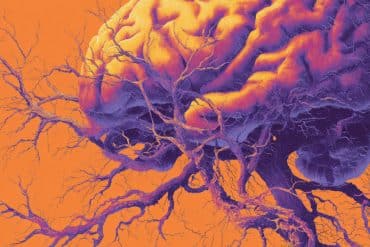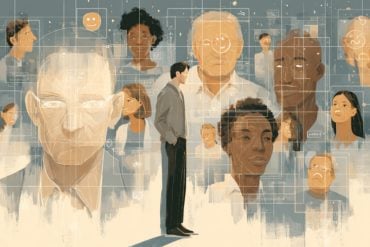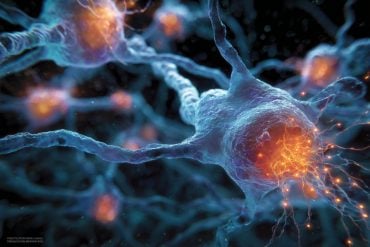Summary: A new study reveals exposure to androgens during brain development can alter genes linked to autism in males.
Source: Elsevier.
Exposure to androgens (male hormones) during brain development alters genes related to autism spectrum disorder (ASD), according to a new study published in Biological Psychiatry. Using male human cells, researchers at the University of Strasbourg, France, identified key genes that are regulated by testosterone and that contribute to the risk for autism, generating important insight into how male hormones might contribute to the increased male susceptibility to ASD.
The findings provide a clue as to why ASD affects boys about four times as much as girls. Male fetuses produce androgens during critical stages of brain development when cells divide and develop into neurons. The researchers showed that androgens increase the spread of cells and prevent them from death, which could predispose boys to ASD by contributing to the excessive brain growth that occurs in people with ASD during the first years of life.
“Understanding the mechanisms for the male preponderance for autism is like pulling on a lose thread. It could help to ‘unravel’ important mechanisms contributing to autism risk,” said John Krystal, Editor of Biological Psychiatry. Identifying a role of androgens in this risk could be important for prevention or the development of potential treatments for ASD.
In the study, co-senior authors Jean-Louis Mandel, M.D., Ph.D., and Amélie Piton, Ph.D., and colleagues used human pluripotent neural stems cells to model the cells that generate neurons during brain development. Treatment with the testosterone metabolite DHT led to subtle changes in the expression of about 200 genes, several of which have previously been associated with ASD. Some of the genes that were most affected by DHT treatment included NRCAM, which has been linked to the brain abnormalities and symptoms in ASD, and FAM107A, which is increased in people with ASD. FAM107A also appeared to play a part in androgen’s ability to increase cell numbers in the study.
“These effects of male hormones may therefore contribute to the increased sensitivity of the male brain to develop ASD when also exposed to other genetic or environmental factors,” said Dr. Piton, suggesting that the biological explanation for the sex-specific inequality of ASD points to a predisposition in males, rather than a protective effect in females.

In addition to providing a clue into the male susceptibility to ASD, Dr. Piton says that the list of genes that were altered by androgens in the study might be useful to identify new genes that might be involved in ASD or in other diseases that occur more often in males.
Source: Justin Dupuis – Elsevier
Publisher: Organized by NeuroscienceNews.com.
Image Source: NeuroscienceNews.com image is in the public domain.
Original Research: Abstract in Biological Psychiatry.
doi:10.1016/j.biopsych.2018.01.002
[cbtabs][cbtab title=”MLA”]Elsevier “Male Susceptibility to Autism Linked to Male Hormones in Early Stage Brain Development.” NeuroscienceNews. NeuroscienceNews, 7 February 2018.
<https://neurosciencenews.com/male-hormones-development-autism-8447/>.[/cbtab][cbtab title=”APA”]Elsevier (2018, February 7). Male Susceptibility to Autism Linked to Male Hormones in Early Stage Brain Development. NeuroscienceNews. Retrieved February 7, 2018 from https://neurosciencenews.com/male-hormones-development-autism-8447/[/cbtab][cbtab title=”Chicago”]Elsevier “Male Susceptibility to Autism Linked to Male Hormones in Early Stage Brain Development.” https://neurosciencenews.com/male-hormones-development-autism-8447/ (accessed February 7, 2018).[/cbtab][/cbtabs]
Abstract
Genes and Pathways Regulated by Androgens in Human Neural Cells, Potential Candidates for the Male Excess in Autism Spectrum Disorder
Background
Prenatal exposure to androgens during brain development in male individuals may participate to increase their susceptibility to develop neurodevelopmental disorders such as autism spectrum disorder (ASD) and intellectual disability. However, little is known about the action of androgens in human neural cells.
Methods
We used human neural stem cells differentiated from embryonic stem cells to investigate targets of androgens.
Results
RNA sequencing revealed that treatment with dihydrotestosterone (DHT) leads to subtle but significant changes in the expression of about 200 genes, encoding proteins of extracellular matrix or involved in signal transduction of growth factors (e.g., insulin/insulin growth factor 1). We showed that the most differentially expressed genes (DEGs), RGCC, RNF144B, NRCAM, TRIM22, FAM107A, IGFBP5, and LAMA2, are reproducibly regulated by different androgens in different genetic backgrounds. We showed, by overexpressing the androgen receptor in neuroblastoma cells SH-SY5Y or knocking it down in human neural stem cells, that this regulation involves the androgen receptor. A chromatin immunoprecipitation combined with direct sequencing analysis identified androgen receptor–bound sequences in nearly half of the DHT-DEGs and in numerous other genes. DHT-DEGs appear enriched in genes involved in ASD (ASXL3, NLGN4X, etc.), associated with ASD (NRCAM), or differentially expressed in patients with ASD (FAM107A, IGFBP5). Androgens increase human neural stem cell proliferation and survival in nutrient-deprived culture conditions, with no detectable effect on regulation of neurite outgrowth.
Conclusions
We characterized androgen action in neural progenitor cells, identifying DHT-DEGs that appear to be enriched in genes related to ASD. We also showed that androgens increase proliferation of neuronal precursors and protect them from death during their differentiation in nutrient-deprived conditions.







